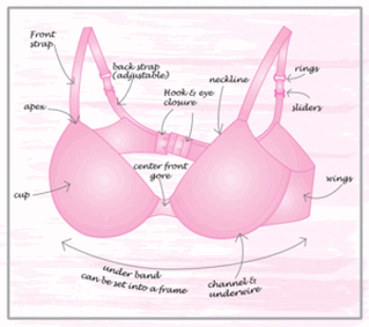Bra Anatomy and its Size
Bra manufacturing requires an in-depth knowledge of the anatomy of Bra which consists of parts like Apex, strap, adjuster, hook, and eye, cup, cradle, sling, wing etc. Each of which plays a very important role and therefore one needs to know them and their correct use.
Bra manufacturing requires an in-depth knowledge of the anatomy of Bra which consists of parts like Apex, strap, adjuster, hook, and eye, cup, cradle, sling, wing etc. Each of which plays a very important role and therefore one needs to know them and their correct use.
The Bra Deconstructed
 Have you ever wondered what bra manufacturers mean when they talk about ‘wings’, ‘slings’ or ‘centre gores’?
Have you ever wondered what bra manufacturers mean when they talk about ‘wings’, ‘slings’ or ‘centre gores’?
Here’s our jargon-busting guide to all the pieces that make up a bra – this can range from 10 pieces for a very basic style to 48 for the most complicated
| Bra Part | Description |
|---|---|
| APEX | The apex is the part of the bra where the strap joins the cup. |
| STRAP | The strap keeps the cup in place but should not take the main weight of the breast. |
| ADJUSTER | The adjuster is used to tighten or loosen the strap accordingly. Its position on the strap can vary and depends on the design of the bra. |
| HOOK AND EYE | You can usually fasten a bra on the first, second or third hook and eye. We recommend that when you buy a new bra, it fits snugly when fastened on the loosest hook and eye. This is because your bra will stretch over time and you will need to use the middle and tightest hooks to keep it firm later on. |
| CUP | The cup is the part of the bra that supports the breast.The bottom part of the cup is often lined for extra support. |
| CENTRE FRONT / CENTRE GORE | The center front or center gore is the piece of the bra that its fat against the chest in between the breasts. It is sometimes part of a cradle. |
| CRADLE | A cradle helps position the wires and cups securely against the chest. Many women therefore and bras with cradles more comfortable to wear. |
| SLING | Some bras incorporate a sling into the inner cup to provide additional support to the side of the breast to stop it from spreading out to the side. It is popular to use a sling in cups for larger breasts or for any size when the outer fabric is too delicate to provide enough support on its own. |
| WING | The wings, when fastened at the back, not only secure the bra to the body but also pull the wires into position to sit around the breast. |
| UNDERBAND / BOTTOM BAND | The underband or bottom band runs along the bottom of the bra and anchors the bra to the body. It should it snugly against the body, providing the majority of the support for the breasts |
Calculation of bra size
To calculate the bra size one should subtract the band measurement (step 1) from the cup measurement (step 2). Generally, for each inch in difference, the cup goes up by one size
28 different types of bra - a complete list of commonly used bra names
Example:
Step 1: 34″ under measurement + 4″ = 38″ band
Step 2: 40″ over the measurement
Step 3: 40″ – 38″ = 2″ or Cup “B”
The following table reveals the standard Cup size of every bra with a given difference in every individual’s size.
| The Difference in measurement: | The Standard Cup Size |
|---|---|
| 0″-1/2″ | (1.3 cm) AA |
| 1/2″- 1″ | (2.6 cm) A |
| 2″ | (5.1 cm) B |
| 3″ | (7.6 cm) C |
| 4″ | (10.2 cm) D |
| 5″ | (12.7 cm) DD * or E * |
| 6″ | (15.2 cm) DDD * or F * |
| 7″ | (17.8 cm) G * |
| 8″ | (20.3 cm) H * |
| 9″ | (22.9 cm) I * |
| 10″ | (25.4 cm) J * |
Note: this measuring system tends to become less accurate as the cup sizes go above a D. Additionally, some manufacturers name larger cup sizes differently.


